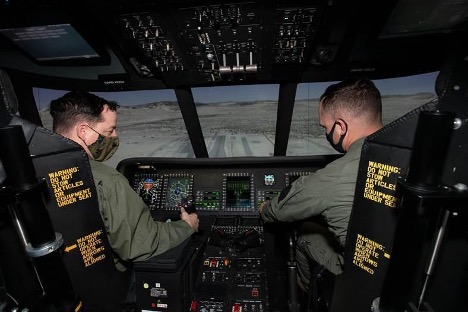By Robbin Laird
Marine Corps Air Station, New River.
Yesterday, during my visit to New River, I experienced flying in the cockpit of the Marine Corps’s latest key air capability, the CH-53K. I was in the cockpit with LtCol Luke “Amber” Frank, the VMX-1 Detachment OIC. He is a very experienced Marine Corps pilot having flown virtually every type of rotorcraft the Marine Corps has, including being a presidential pilot as well.
He is experienced; obviously I am not.
So where did this flight happen?
In the new flight simulator which has been built and is operating at VMX-1.
The man-machine working relationship is a central part of the flight experience, with new capabilities crucial to mission success built around key man-machine capabilities.
A central one is the ability of the aircraft to hover with the automatic system, which allows pilots to operate in very degraded operating conditions to put down their aircraft at desired locations to deliver their payloads.
During our flight, in spite of the bright clear but cold day outside, we experienced several difficult landings in degraded conditions, dust storms, turbulence, and various challenging situations to land the aircraft.
Why does this matter in terms of concepts of operations?
This means that the crew can deliver the payload, Marines or cargo, to the area which is desired in terms of commander’s intent with regard to the landing zone selected for maximum combat effectiveness.
If one is inserting a force to support an effort to destroy key enemy capabilities, being able to take the right kind of situational awareness and land EXACTLY where the commander has determined the force could have the highest combat effect is a core combat capability with tactical and even potentially strategic effect.
This is how a capability within a new aircraft translates into enhanced probability for combat success.
And if you are an allied military which needs capability to insert force rapidly in special operations environment, the CH-53K could be a game changing capability for force insertion.
After my CH-53K ‘flight,’ I toured the first of the VMX-1 CH-53ks on the flight line. What quickly leaps out at you inside the aircraft, is the configuration to manage standard USAF pallets for rapid load and off-load operations.
In the near future, I will publish my interview with LtCol Frank.
And in an interview with Sean Cattanach, Sikorsky’s senior program manager of the U.S. Marine Corps CH-53K Training System, USNI News reported: “One of the benefits of developing a training system concurrently with the aircraft is that we’re able to utilize the digital designs from the aircraft to make sure the training is accurate.”
Bill Falk, Sikorsky CH-53K program director, added in a statement: “The training devices will ensure a flawless entry into service for the CH-53K heavy-lift helicopter.”
CH53-K Training Suite Video from RMS Creative Solutions on Vimeo.


